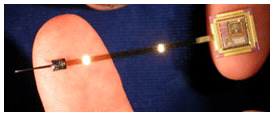 Ann Arbor, Michigan — A ribbon-like cochlear implant developed at the University of Michigan could greatly improve hearing for profoundly deaf patients, and simplify insertion to help surgeons minimize damage to healthy ear tissue.
Ann Arbor, Michigan — A ribbon-like cochlear implant developed at the University of Michigan could greatly improve hearing for profoundly deaf patients, and simplify insertion to help surgeons minimize damage to healthy ear tissue. A team led by U-M's Kensall D. Wise, director of the NSF Engineering Research Center for Wireless Integrated Microsystems (WIMS), made the implant using thin-film electrode sites that directly stimulate the auditory nerve.
The implant is currently being tested in guinea pigs and cats, said Wise, who has appointments in the departments of Biomedical Engineering and Electrical Engineering and Computer Science. The device may be available in four to five years for use in humans, Wise said, and could be used in current cochlear patients—removing the old device first—to improve their hearing. Additionally, the FDA approves implants for wider use as the technology improves.
Approximately 100,000 patients today have received cochlear implants worldwide. The current technology, Wise said, is bulky, difficult for surgeons to insert, and doesn't allow a great range of perceived frequencies. The present implants use electrodes formed from a bundle of wires fed into the snail-shaped cochlea of the inner ear, but difficulties in inserting such devices make it tough to achieve the deep insertion needed to stimulate lower-frequency sounds, and collisions with the cochlear wall can damage any residual hearing that still exists.
"The range of frequencies that can be stimulated depends on how far into the cochlea the implant can go, with the lower frequencies located further up toward the apex of the spiral canal," Wise said. In current technology, each implant has anywhere from 16 to 22 stimulating sites along its length. By contrast, the U-M implant will host up to 128 stimulating sites.
"More sites mean greater tonal range and better frequency perception," Wise said, "and the implant's flexibility will minimize damage to existing hearing."
The ribbon film technology lets researchers embed other functions in the implant, such as position sensors that allow surgeons to watch the implant's progress on a monitor as they're feeding it into the cochlea.
"With the position sensors, doctors can see, on a screen, a silhouette of the ribbon against the shape of the cochlea," Wise said. "Eventually the idea is to be able take the signals from the position sensors and use them to control actuators in an insertion tool, so that the electrode array can achieve deep insertion and navigate around any obstacles in its path.
"The idea is to use a pneumatic insertion tool that can be inflated or deflated, similar to a spiral party favor, and is pre-stressed to hug the inner wall of the cochlea," Wise said. "The position sensors set the stage for doing that because they give you feedback on what's happening when you insert these devices."
Researchers make the implant with the same processes used to make integrated circuits, which means they can be made in batch. The research is funded by the National Science Foundation and was to be presented on Feb. 6 at the International Solid-State Circuits Conference (ISSCC) in San Francisco. Doctoral student Pamela Bhatti was to present the paper, which is co-authored by Wise and by research fellow Sangwoo Lee.
For information on Wise, visit www.eecs.umich.edu/~wise/
Taken from www.umich.edu/news/?Releases/2006/Feb06/r020606a

